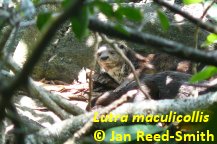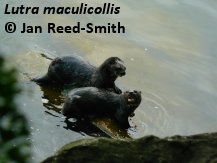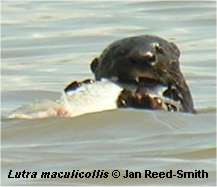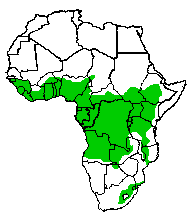|
|
Click on the images below to see more of this species



More photos would be welcomed |
|
Description
This medium-sized otter is around 1.1m long and weighs about 6kg. The fur can be very variable in colour but is usually dark brown, with distinctive spots and streaks of paler colour on the throat,
neck and often upper lip. The paws are fully webbed, with well-developed claws, but the teeth are rather small. It is long and sleek, and more aquatic than the other African otters. The teeth are specialised for catching fish, rather than the broad, crustacean-crushing molars of the clawless otters, although in less fish-rich parts of the range, fish, crabs and frogs form the diet in roughly equal proportions.
The basic social unit is mother and cubs but this species can be
quite social. At times groups of adult males, juveniles, or multiple
females and young are known to associate for several days or hours if
adequate prey and habitat is available. As adult males age they appear
to become more solitary but home ranges can overlap. Group foraging has
been observed but not cooperative hunting. This species can be quite social, forming large single-sex groups which swim together at certain times of year if there is sufficient prey to support them.
The taxonomic position of this species has recently been revised and
is now classified as Hydrictis maculicollis
Pocock 1921 based on DNA evidence (Koepfli et al. 2008, Sato et al
2012). Historically it has been known as Lutra
and Hydrictis.
CITES Identification Sheet
Afrikaans: Kleinotter
English: Spotted-Necked Otter, Speckle-throated Otter
French: Loutre à cou tachete
German: Fleckenhalsotter
Kiswahili: Fisi maji mdongo
Tswana: leNyibi
Zulu: inTini
Italian: Lontra del caollo macchiato
Spanish: Nutria de cuello manchado
Habitat
Spotted-Necked Otters are very aquatic and require permanent water
sources with high fish densities. They prefer larger rivers, lakes and
swamps with open areas of water. They appear to only make use of fresh
water habitats. Because they mainly hunt by sight, they need clear,
unpolluted water where there are numerous small fish, or fish, crabs and
frogs. Long reeds, grass, bushes, or large rocky shorelines are
essential to provide cover for resting and denning. Currently the most suitable habitat is the large fish-rich African lakes and the deep, clear areas of the Botswanan Okovango.
Distribution
Their historic distribution is large, but their population is
believed to be in decline throughout their range with pockets of strong
populations. It occured in all countries south of Sahara, from Senegal to Ethiopia and south to the Cape provinces where there is suitable habitat.
Currently it is considered possibly still present in 13 countries,
confirmed presence within the last 10 years in 19 countries, and
believed to be extirpated in four countries.
Conservation Status
Red List Category Near Threatened, Decreasing
Year Assessed 2014
Assessor Reed-Smith, J., Jacques, H., Somers, M.
Evaluators Hussain, S.A. (Otter Red List Authority) & Duplaix, N.
Current Concerns
The IUCN Red-List 2014 assessment states: "The Spotted-necked otter
is decreasing throughout its range, mainly as a result of the alteration
or degradation of freshwater habitats and riparian vegetation. This
rapid habitat loss is exacerbated by a growing, poor population engaged
in unsustainable agricultural activity and unsustainable fishing
practices. These practices have led to bank and shoreline erosion,
denuding of important vegetative cover used by the otters, increased
human presence which is disruptive to otter denning, increased use of
smaller mesh nets and poisoning to improve catches, and the change or
depletion of the otters prey base. Pollution of waters with
agricultural, livestock, and societal wastes also are threatening with
evidence of the bioaccumulation of organochlorines and other
biocontaminants recorded in Spotted-necked Otters. The rate of otters
becoming entangled in set and discarded fishing nets is impossible to
determine however, based on known entanglement of other species it has
likely increased over the occassional drowning reported previously.
Otters are also killed for food or skins, as a perceived threat to
poultry, or as a competitor for fish. Introduction of alien fish species
that out-compete the smaller indigenous fish was identified as a main
threat for the Lake Victoria population."
Although international and national level legal protection is in place, enforcement is needed. There is a need for increasing local awareness of the species.
Leading Researchers
A. Lejeune, I. d'Inzillo Carranza, M.A.E. Mortimer, J. Procter, D.
Rowe-Rowe, M. Somers, J. Reed-Smith
Key Publications
-
Kruuk, H. & Goudswaard, P.C. (1990) Effects of Changes in Fish Populations
in Lake Victoria on the Food of Otters (Hydrictis maculicollis Schinz and
Aonyx capensis Lichtenstein) (sic) Afr. J Ecol 28:
322 – 329
- Larivière, S. (2002) Hydrictis maculicollis. Mammalian Species 712 : 1 – 6, 3 figs.
- Lejeune, A. (1989a) Ethologie des Loutres (Hydrictis maculicollis) au lac Muhazi, Rwanda. Mammalia 53 : 191 – 202
- Lejeune, A. (1989b) Les loutres, Lutra (Hydrictis) maculicollis Licht. et la Pêche Artisanale. J. Afr. Zool. 103: 215 - 223
- Lejeune, A. (1990) Ecologie Alimentaire de la loutre (Hydrictis maculicollis) au lac Muhazi, Rwanda. Mammalia 54 : 33 – 45
- Mortimer M.A.E. (1963) Notes on the Biology and Behaviour of the Spotted-Necked Otter (Hydrictis maculicollis). Puku 1: 192 – 20
- Nel, J.A.J. & Somers, M. (1998). The status of otters in Africa: An assessment. Proceedings of the VII International Otter Symposium, 13-19 March 1998. Trebon, Czech Republic.
- Perrin, M.R. & d’Inzillo Carranza, I. (1999) Capture, Immobilization and Measurements of the Spotted-Necked Otter in the Natal Drakensberg, South Africa. S. Afr. J. Wildl. Res. 29: 52 – 53
- Perrin, M.R. & d’Inzillo Carranza, I. (2000a) Activity Patterns of Spotted-Necked Otters in the Natal Drakensberg, South Africa. S. Afr. J. Wildl. Res. 30: 1 – 7
- Perrin, M.R. & d’Inzillo Carranza, I. (2000b) Habitat Use by Spotted-Necked Otters in the KwaZulu-Natal Drakensberg, South Africa. S. Afr. J. Wildl. Res. 30: 8 - 14
- Perrin, M.R. & d’Inzillo Carranza, I. & Linn, I. J. (2000) Use of Space by the Spotted-Necked Otter in the KwaZulu-Natal Drakenberg, South Africa. S. Afr. J. Wildl. Res. 30: 15 – 21
- Procter, J. (1963) A Contribution to the Natural History of the Spotted-Necked Otter (Hydrictis maculicollis Licht.) in Tanganyika. E. Afr. Wildl. J. 1: 93 – 102
- Reed-Smith, J. (2010). An Assessment of
Seasonality and Shoreine Characteristics Associated with Latrine
Site Use by Spotted-necked otter (Lutra maculicollis Lichtenstein,
1835) with a Preliminary Report on Spotted-necked Otter Behaviour on
Rubondo Island National Park, Tanzania. George Mason Univ. M.A.
Project.
- Reed-Smith, J., I. Olouch, M. Origa, T.S. Kiheu, M.M.
Muhabi, M.M. Yusuf, M. Ogada, A. Lobura, T. Serfass. (2010).
Consumptive uses of and lore pertaining to spotted-necked
otters in East Africa - a preliminary report from the Lake Victoria
area of Kenya, Tanzania, and Uganda. IUCN Otter Spec. Group Bull.
27(2):85-88; 2010.
- Reed-Smith, J., T. Serfass, T.S. Kihudu, M. Mussa.
(2014). Preliminary Report on the Behaviour of
Spotted-Necked otter (Lutra maculicollis, Lichtenstein,
1835) Living in A Lentic Ecosystem. Zoo Biology 32(2) Mar/Apr
2014:121-130.
- Rowe-Rowe, D. T. (1977a). Food ecology of otters
in Natal, South Africa. Oikos 28:210-219.
- Rowe-Rowe, D. T. (1977b). Prey capture and feeding
behaviour of South African otters. The Lammergeyer 23:13-21. Rowe-Rowe, D. T. (1992).
Survey of South African otters in a fresh-water habitat, using sign. South African J. of Wildl. Research 22:49-55.
- Rowe-Rowe, D.T. (1990). Action plan for African otters:
41 - 51. In: Otters: An action plan for their
conservation. IUCN/SSC, Gland,
Switzerland.
- Rowe-Rowe, D.T. (1995). Distribution and status of African otters.
In: Reuther, C. & Rowe-Rowe, D. (Eds) Proc.
V l International Otter Colloquium, Pietermaritzburg 1993. Habitat 11 : 8 -
1 0.
- Rowe-Rowe, D.T. & Somers, M.J. (1998). Diet, foraging
behaviour, and
coexistence of African otters and the water mongoose. Symposia
of the Zoological Society of London 71: 216-227
- Smith, L. (1993) Otters and Gillnet
Fishing in Lake Malawi National Park IUCN Otter Spec. Group
Bull. 8: 4 -6
- Somers, M.J.& M.G. Purves, (1996). Trophic overlap between three
syntopic semi-aquatic carnivores: Cape clawless otter, spotted neck
otter and water mongoose. African J. of Ecology 34:158-166.
Useful Links
|





